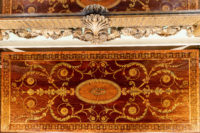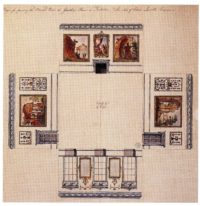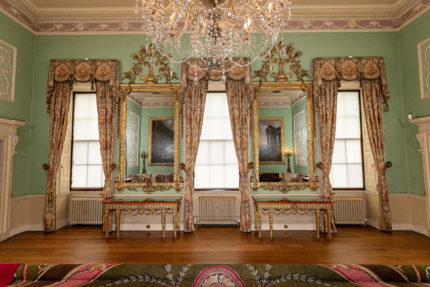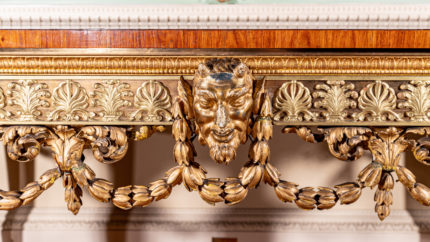A set of matching pier tables and mirrors by Thomas Chippendale have been acquired for the nation under the Acceptance in Lieu scheme. The pair of marquetry inlay tables and Neoclassical looking glasses were given to government by the Trustees of the 7th Earl of Harewood’s Will Trust in lieu of inheritance tax. They have been allocated to the Victoria and Albert Museum, but will not budge from their current location, the Music Room at Harewood House, Yorkshire.
Chippendale was commissioned by Edwin Lascelles, 1st Baron Harewood, to furnish and decorate his newly-built estate. Harewood House was constructed from 1759 to 1771, and the nouveau baron spared no expense on his new seat. Lascelles hired Thomas Chippendale, recognized as the greatest furniture-maker in England, in 1767, before the mansion was even complete. Chippendale visited Harewood that summer and began making preparatory designs.
Chippendale’s Harewood House commission was the most extensive in range of objects, quality of materials and decoration of his career. It was also the most expensive. The surviving records are spotty, but estimates place the value of the contract to more than £10,000 (about $2 million in today’s money).
The first furnishings arrived from Chippendale’s London workshop in April of 1769 and kept coming, literally by the ton (the transportation bills have survived), on a regular basis for years. We know from Chippendale’s records that his team fully furnished three major rooms on the principal floor (the State Bedchamber, State Dressing Room, the Yellow Damask Sitting Room ) and the main staircase area. Harewood’s Day Work Book, kept by steward Samuel Popelwell, record the Chippendale workmen installing furniture in the Dining Room, Library and Music Room. A 1795 inventory records Chippendale pieces in the entrance hall, back stairs and passages, the superior rooms in the basement (Billiards Room, Coffee Room, Stewards Room) and top floor apartments for family and guests.
He didn’t just make the furniture. Chippendale was also tasked with creating window cornices, borders and finishes on the wall coverings, paper and damask (which his workmen hung in all the main rooms), and chimney pieces. While the elaborate plaster moldings in the Music Room were designed by Robert Adam, Chippendale collaborated with Adam and carved the gilded reliefs of the tables and frames of the mirrors to match the ones in the room.
 The table tops are rosewood with satin-wood, tulip-wood and other veneers inlaid in patterns of acanthus and anthemion leaf spirals. Marquetry inlay in floral patterns became fashionable in the mid-1750s in France, but it didn’t cross over to England until the dawn of Neoclassicism a decade later. Thomas Chippendale was one of the pioneers of the technique in England. The legs and frames are gilded in a two-tone style, gold and silver, that was popular in French furniture of the time. The mirrors frames also match the plasterwork motifs with carved anthemion and scrolling acanthus leaves on the apron and cresting.
The table tops are rosewood with satin-wood, tulip-wood and other veneers inlaid in patterns of acanthus and anthemion leaf spirals. Marquetry inlay in floral patterns became fashionable in the mid-1750s in France, but it didn’t cross over to England until the dawn of Neoclassicism a decade later. Thomas Chippendale was one of the pioneers of the technique in England. The legs and frames are gilded in a two-tone style, gold and silver, that was popular in French furniture of the time. The mirrors frames also match the plasterwork motifs with carved anthemion and scrolling acanthus leaves on the apron and cresting.
 The views of ancient ruins reflected in the mirrors are by Neoclassical painter Antonio Zucchi who collaborated with Robert Adam on the decoration of several stately homes. They can be seen in Adam’s original plan for the room. The mirrors are in the plan too, with only small differences from the final pieces.
The views of ancient ruins reflected in the mirrors are by Neoclassical painter Antonio Zucchi who collaborated with Robert Adam on the decoration of several stately homes. They can be seen in Adam’s original plan for the room. The mirrors are in the plan too, with only small differences from the final pieces.
Over the centuries pieces of Harewood House’s Chippendale furniture have been sold, chipping away (no pun intended) at the greatest single collection of his works in their original context. The Acceptance in Lieu scheme allows the Trust a financial benefit without losing the pieces Thomas Chippendale made specifically for the space. The V&A has formalized the arrangement with a long-term loan that will keep the Music Room almost exactly as Robert Adams designed it.
The tables and glasses will undergo a programme of conservation by the V&A’s conservators to restore the surface finish closer to Chippendale’s original intention.
Tristram Hunt, Director, V&A said: “It is exceptionally rare to find Thomas Chippendale furniture as well documented as that at Harewood House – the most lavish commission Chippendale ever received. Of superlative quality, the tables and glasses are welcome additions to the V&A’s world-class collection of English furniture. We are delighted that they can remain in their original location to be seen and appreciated by visitors to Harewood House for years to come.”

